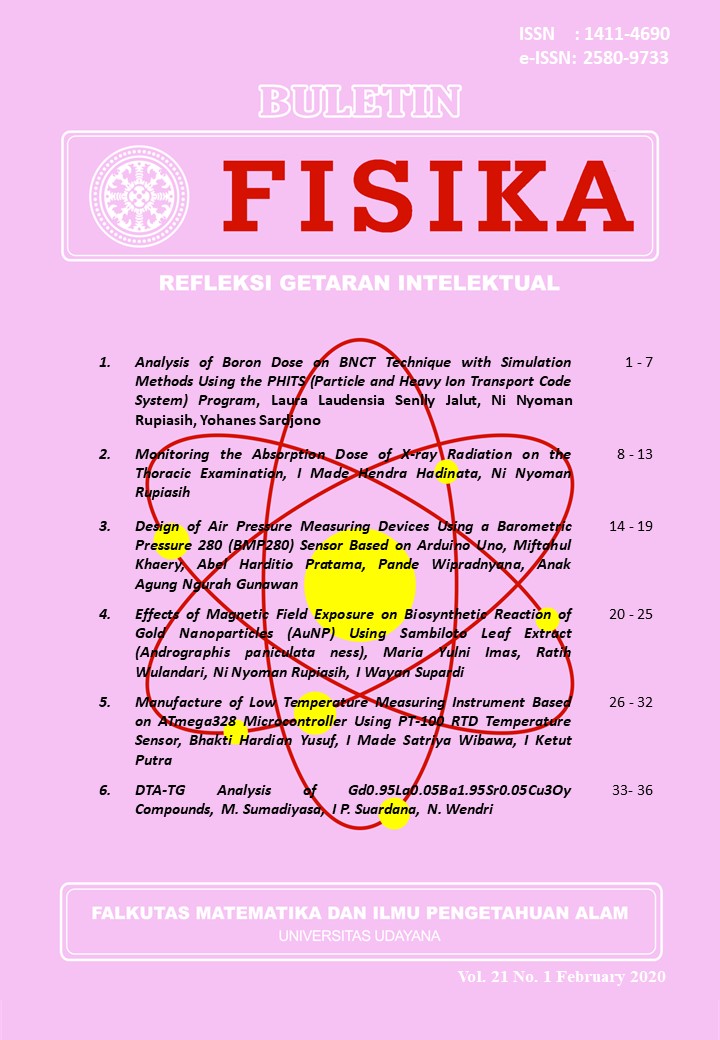Analysis Dosage of Boron in BNCT with Simulation Method Using PHITS (Particle and Heavy Ion Transport Code System) Program
Abstract
Abstrak – Cancer is a dangerous disease which is one of the main causes of death in the world, which is 8.8 million deaths in 2015. A new method has been developed for the treatment of cancer with small side effects, Boron Neutron Capture Therapy (BNCT). BNCT is based on the ability of non-radioactive isotopes Boron-10 to capture thermal neutrons. Boron is the main key of the BNCT process wherein, radiation of cancer cells can be carried out selectively if the cancer contains high concentrations of boron. Boron doses in cancer cells cannot be measured directly, therefore artificial network methods are used to compute doses computationally, namely the Monte Carlo method with the Particle and Heavy Ion Transport Code System (PHITS) program. Boron dose used was 10, 20 and 30 ?g/g. It was found that the greater the boron dose the greater the number of neutrons absorbed. The results showed that the largest absorption dose occurred in the Gross Tumor Volume (GTV) area of ??7.7076E-10 Gy/cm2.
Key words: Cancer, BNCT, Dose of Boron, PHITS.
Downloads
References
[2] WHO, 2017, World Health Statistic, 2017, World Health Organization (WHO).
[3] Aznam, N., 2012, Potensi Rimpang Tumbuhan Kunci Pepet (Kaempferia Rotunda) Sebagai Anti Kanker, Artikel Kerjasama Internasional, Fakultas MIPA Universitas Negri Yogyakarta.
[4] Heydari F., 2015, Tehran Research as a Neutron Source for Boron Neutron Capture Therapy in Iran: A cancer Treatment plan for Future, International Conference on Advances in Agricultural, Biological & Environmental Sciences (AABES-2015).
[5] Yoshioka M., 2016, Review of Accelerator-Based Boron Neutron Caprure Therapy Machines, Okinawa Institute of Science and Technology Graduate University, Onna-son, Japan.
[6] Rosidah S., dkk, 2017, Analisis Dosis BNCT pada Kanker Kulit Melanoma Menggunakan MCNPX dengan Sumber Neutron dari Kolom Termal Reaktor Kartini, Jurnal Fisika Volume 6, Nomor 5, Tahun 2017.
[7] Prejac J., dkk, 2018, Assessing the Boron Nutritional Status by Analyzing its Commulative Frequenci Distribution in the Hair and Whole Blood, Journal of Trace Elements in Medicine and Biology 45 (2018): 50-56.
[8] Setiyadi, A., 2016, The Dosis of Boron Neutron Capture Therapy (BNCT) toward Skin Cancer (Melanoma Maligna) using MCNPX-CODE with Neutron Source from Kartini Reactor Beamport, Jurnal Fisika Volume 5, Nomor 1, Hlm 66-67.
[9] Sato, T. dkk., 2014, Overview of particle and heavy ion transport code system PHITS, Nucl. Energy (2014), http:// dx.doi.org/10.1016/j.anucene.2014.08.023.
[10] Gede, 2016, Analisis Pemantauan Paparan Radiasi pada Pilot Plant BNCT, Yogyakarta: Penerbit Lintang Pustaka Indonesia ,5.
[11] Huang, J., 2009, Boron Neutron Capture Therapy for Cancer Treatments, Dapartemen of Physics, Faculty of electronics and Physical Sciences,University of Surrey.
[12] Zesgin, B, 2010, Effect of Boron on Human Health, in the Open Mineral Processing Journal 3(1): 54-59.
[13] Mahmud K. H. N., 2017, Analisis Dosis Boron Neutron Capture Therapy (BNCT) pada Kanker Otak (Glioblastoma Multiform) Menggunakan MCNPX-Code dengan Sumber Neutron dari Kolimator Kolom Termal Reaktor Kartini, Universitas Negri Yogyakarta.
[14] Athiqoh, F. dkk., 2014, Distribusi Fluks Neutron Sebagai Fungsi Burn-Up Bahan Bakar Reaktor Kartini, Youngster Physics Journal, Vol. 3, No. 2, April 2014, Hal 107-112.
[15] Sauerwein, W., Moss, R., 2009, Requirement for Boron Neutron Capture Therapy (BNCT) at a Nuclear Research Reactor. Belanda: The European BNCT Project.
[16] Sato, T. dkk., 2017, Recent Improvements of Particle and Heavy Ion Transport code System: PHITS, EPJ Web of Conferences 153, 06008 (2017), ICRS-13 & RPSD-2016.











